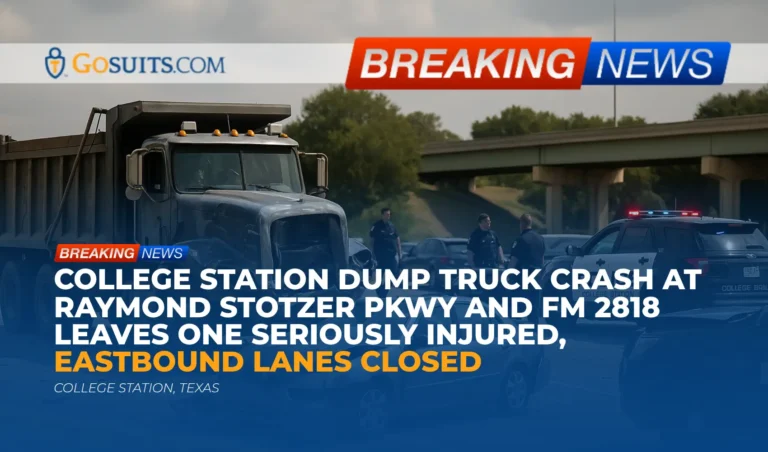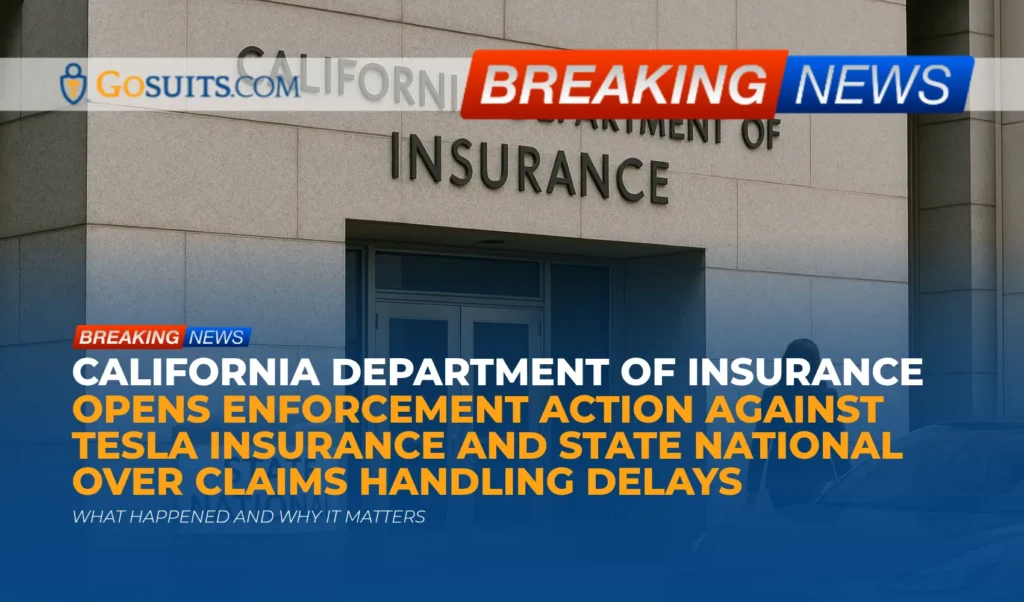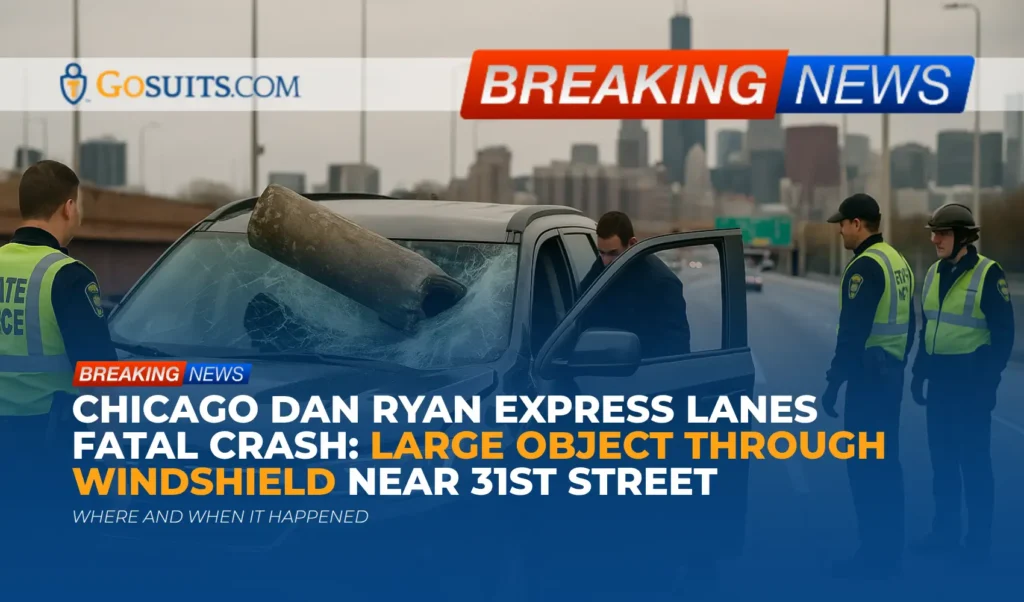- Incident overview and what we know
- Where and when the crash occurred
- Law enforcement response and ongoing investigation
- Potential causes in multi-vehicle crashes involving dump trucks
- Injuries and immediate care considerations
- What evidence matters after a heavy-truck crash
- How liability may be evaluated under Texas law
- Insurance considerations and the claims process
- Important Texas civil deadlines to know
- Getting official records and help in College Station and Brazos County
- Safety insights for the community near the diverging diamond
- Steps to take before speaking with any insurance company
- Why acting promptly matters
- Commentary from Gosuits College Station, Texas Personal Injury Attorney
Incident overview and what we know
On Friday, October 3, 2025, around 2 p.m., a collision involving a dump truck and multiple other vehicles occurred on Raymond Stotzer Parkway at FM 2818 near Easterwood Airport in College Station, Texas. According to public updates from the College Station Police Department, eastbound lanes of Raymond Stotzer Parkway were closed while officers investigated. At least one person sustained serious injuries and was transported to a nearby hospital. As of the latest public statements, no additional details about the number of people involved, contributing factors, or the condition of the seriously injured person have been released.
In the aftermath of a serious heavy-truck crash, it is common for law enforcement to secure the scene to reconstruct events, document vehicle positions and roadway evidence, and interview witnesses. That process can take several hours, especially when a commercial vehicle like a dump truck is involved. The information below is intended to help community members understand what typically happens next, what records exist, and how civil claims are often evaluated, while remaining respectful of the limited facts that have been formally disclosed.
Where and when the crash occurred
Location details matter both for safety and for later civil claims. This collision occurred on Raymond Stotzer Parkway at FM 2818 near Easterwood Airport. The area includes a diverging diamond interchange nearby, which changes traffic flow to improve safety and capacity. The reported timing was approximately 2 p.m., a period when traffic volumes can be steady and visibility is typically good. No official statement has yet identified weather, visibility, or traffic-control issues as factors.
Knowing the precise milepoint or intersection is useful when requesting crash documents and traffic signal data, if relevant. It can also assist in locating nearby surveillance cameras that might have captured the incident, such as roadway cameras, adjacent businesses, or airport-adjacent systems, if any exist in view of the roadway.
Law enforcement response and ongoing investigation
The eastbound lanes were closed by the College Station Police Department to facilitate investigation and safe cleanup. During this phase, officers typically collect physical evidence, measure skid and yaw marks, note damage patterns, evaluate load securement if a truck is carrying material, and document any hazardous debris. When a commercial vehicle is part of a multi-vehicle crash, investigators may also review driver logs, vehicle inspection status, and other material that can be relevant in a civil context.
After the scene is cleared, the investigating officer prepares a Texas Peace Officer’s Crash Report, commonly called the CR-3. Under Texas practice, eligible parties can purchase an official copy through the Texas Department of Transportation’s Crash Records Information System. The state’s official portal is available here: TxDOT CRIS Crash Report Search.
Potential causes in multi-vehicle crashes involving dump trucks
It is too early to draw conclusions about this specific crash. In general, however, multi-vehicle collisions involving heavy trucks can involve a range of factors. Federal and state safety agencies recognize that heavy vehicles require longer stopping distances and impose different visibility and handling challenges compared to passenger cars. The following are common considerations investigators and engineers evaluate in serious truck-involved collisions.
- Stopping distance and following distance. Heavier vehicles require more time and distance to stop. National Highway Traffic Safety Administration publications routinely address the risks of large-truck stopping distances in serious crashes. See NHTSA’s traffic safety facts for large trucks for data-driven context: NHTSA CrashStats.
- Driver alertness and hours of service. Federal Motor Carrier Safety Administration rules govern how long many commercial drivers can be on duty and require rest breaks in interstate commerce. While local dump truck operations may be intrastate and subject to specific state adaptations, the federal framework explains why investigators often check duty status and rest. Summary information is available from FMCSA here: FMCSA Hours of Service.
- Vehicle inspection, repair, and maintenance. Mechanical condition matters. Brakes, tires, and steering components are critical in heavy vehicles. Carriers are required to maintain and retain certain inspection and repair records. See 49 CFR Part 396 guidance at FMCSA: FMCSA Part 396.
- Load securement and weight. For dump trucks, the nature of the cargo and whether the bed is loaded can affect handling and stopping. Overloading or shifting loads can increase crash risk.
- Roadway design and traffic control. Intersections and interchanges are complex environments. The Federal Highway Administration highlights how design features, including diverging diamond interchanges, change conflict points and driver expectations. General safety and design details are discussed by FHWA here: FHWA Diverging Diamond Interchange Safety.
- Visibility and conspicuity. Sun angle, glare, and sightlines may be reviewed. NHTSA and FHWA research often analyzes environmental conditions, lighting, and sight distance in severe crashes.
A thorough civil evaluation typically integrates physical evidence, vehicle data, driver statements, and third-party sources such as nearby cameras. Importantly, none of these factors should be assumed in this crash until official findings are released.
Injuries and immediate care considerations
Police confirmed that one person suffered serious injuries and was taken to a hospital. In the hours and days after a crash, it is common for additional injuries to appear due to adrenaline masking pain and delayed symptoms. Regardless of initial impressions, a careful medical evaluation is crucial.
Patients and their authorized representatives have the right to obtain copies of medical records that document diagnoses, imaging, treatment plans, and discharge instructions. The federal right of access to medical records, including time frames and permissible fees, is explained by the U.S. Department of Health and Human Services here: HHS: Access to Medical Records. These records become important in any civil claim to show the nature of injuries and the care required.
If there are catastrophic injuries, families sometimes face decisions about acute rehabilitation, home modifications, and work capacity. Documenting time missed from work, out-of-pocket costs, and communications with insurers can preserve important details for later. Nothing in this article replaces medical advice; decisions about care should be made with licensed clinicians.
What evidence matters after a heavy-truck crash
Evidence can be lost quickly. Even while official investigations proceed, some items are uniquely in the hands of private parties. The following types of evidence frequently matter in collisions involving a dump truck and multiple vehicles.
- Police crash report and scene documentation. The Texas Peace Officer’s Crash Report (CR-3) and any diagram or narrative help show vehicle paths and points of impact. Eligible parties can request the CR-3 through TxDOT’s portal: TxDOT CRIS Crash Reports.
- Carrier records. Motor carriers must keep certain safety and crash-related records. Federal rules require a crash register and related materials, which can include reports, witness statements, and repair estimates maintained by the motor carrier. See 49 CFR 390.15 at FMCSA: FMCSA Accident Register Rule. Inspection and maintenance records are covered in Part 396: FMCSA Part 396.
- Vehicle electronic data. Some heavy trucks and many passenger vehicles store event data such as speed change, throttle, and braking inputs. Preserving this data often requires prompt action.
- Dashcams and nearby video. In a corridor near an airport and busy interchange, surrounding businesses or transportation facilities may have cameras. Footage is often overwritten within days or weeks.
- Load and dispatch information. For a dump truck, documentation of what was being hauled, gross vehicle weight, route, and timing can help answer whether loading or scheduling practices played a role.
- Medical records and billing. Hospital records, imaging, therapy notes, pharmacy receipts, and mileage or caregiving logs help document recovery. See HHS guidance on access rights: HHS: Access to Medical Records.
Because companies may have record-retention schedules as short as a few months, timing matters. For example, certain duty status records are typically retained for six months under federal rules for carriers who are subject to those provisions. See FMCSA hours-of-service information for context: FMCSA Hours of Service.
How liability may be evaluated under Texas law
Texas civil law evaluates negligence by asking whether a person or entity failed to use ordinary care under the circumstances and whether that failure caused harm. When multiple parties may share fault, Texas applies proportionate responsibility rules.
- Comparative fault framework. Texas Civil Practice and Remedies Code Chapter 33 governs proportionate responsibility. A trier of fact can apportion percentages of responsibility among involved parties. The statute is published by the State of Texas here: Tex. Civ. Prac. & Rem. Code Chapter 33.
- Potentially responsible parties. In a multi-vehicle crash involving a dump truck, possible civil responsibility can extend to a truck driver, the motor carrier or contractor operating the truck, a maintenance provider, or others whose actions contributed to the events. In rare situations, roadway design or signal timing concerns can be evaluated, but this requires careful engineering analysis and is not suggested here without evidence.
- Negligent entrustment, hiring, training, or supervision. If a truck operator lacked appropriate qualifications or if a carrier ignored safety warnings, a civil claim may examine those practices. That analysis typically involves reviewing personnel, training, and safety records, subject to applicable evidentiary rules.
- Equipment condition and loading. Brake condition, tire health, and load securement are frequent points of inquiry with heavy vehicles. Requirements for maintenance documentation appear in federal regulations summarized by FMCSA: FMCSA Part 396.
Every collision is different. The role of proportionate responsibility is to account for the real-world complexity of multi-vehicle incidents without presuming fault before the facts are known.
Insurance considerations and the claims process
Heavy trucks generally carry commercial liability coverage, and passenger vehicles carry personal auto policies. Multi-vehicle crashes can involve several insurers. Statements made early in the process can affect later evaluations. Before speaking with any insurance company, it is wise to consult with a qualified attorney and request a free consultation to understand rights and responsibilities; what someone says to an insurer can be recorded and may be used against them later. The following points are offered as general information.
- Property damage and vehicle preservation. If a vehicle is towed, try to note the tow yard location and request that the vehicle be preserved until photos and inspections can be completed.
- Medical payments and health insurance coordination. Some auto policies include medical payments coverage. Health insurance coordination is often necessary to avoid gaps in care. Keep all explanation-of-benefits letters and invoices.
- Recorded statements. Insurers may ask for recorded statements. These can be used to question later claims about pain, missed work, or limitations. Consider obtaining legal guidance before giving any recorded statement.
- Commercial carrier communications. Carriers and their insurers sometimes deploy rapid response teams to a crash scene. Communications with them should be approached carefully.
- Subrogation and liens. Health insurers and some benefit plans may assert reimbursement rights. Understanding these issues early can prevent surprises at settlement time.
If a claim is pursued, documentation that supports injuries, time away from work, and other losses needs to be organized. The police report, photos, repair estimates, and medical records form the spine of most civil evaluations.
Important Texas civil deadlines to know
Texas law imposes deadlines that can affect civil claims. Missing a deadline can limit or extinguish rights, so awareness matters.
- General two-year limitations period. Most personal injury claims in Texas must be filed within two years of the date of injury. See Texas Civil Practice and Remedies Code section 16.003, published by the State of Texas: Tex. Civ. Prac. & Rem. Code § 16.003.
- Wrongful death and survival claims. If a crash results in a fatality, related civil claims also generally follow a two-year period, though the precise accrual rules can vary based on the statute. See the same chapter for statutory text: § 16.003.
- Government-related claims. Claims involving governmental units can include notice requirements and immunities that differ from typical cases. This article does not address any such claim in this incident because there is no indication of government vehicle involvement.
Because each situation is unique, time calculations should be reviewed carefully in light of the specific facts.

Getting official records and help in College Station and Brazos County
The following resources can help families and involved drivers locate official documents and public information connected to this crash. Where possible, links to government sources are provided. Availability and eligibility rules can apply.
Police crash report
Texas provides official crash reports to eligible requestors through the Department of Transportation’s Crash Records Information System. You can search and purchase a CR-3 by date, location, and involved names here: TxDOT CRIS Crash Report Search. The report typically becomes available after the investigating officer completes and submits it.
College Station public information requests
Additional materials such as 911 audio, CAD logs, or certain videos may be requested under the Texas Public Information Act. The Office of the Attorney General provides guidance on how to make a request to a Texas governmental body: Texas OAG: How to Request Public Information. For requests specific to the City of College Station or its Police Department, you can use the city’s public information procedures as outlined on official city channels.
Medical records
Patients or their personal representatives can request copies of medical records from hospitals and clinics providing treatment. Federal guidance on the right to access medical records, including timeframes and permitted costs, is provided by HHS: HHS: Access to Medical Records.
If a fatality is involved
There has been no official report of a fatality in this crash. If a related death were to occur, families in Brazos County can often obtain guidance from county offices regarding death investigations. Brazos County’s main government site is here: Brazos County, Texas. In Texas counties without a medical examiner, a Justice of the Peace oversees death inquests and may order autopsies.
Death certificates
Certified copies of Texas death certificates are issued through the Department of State Health Services Vital Statistics Section. Information on eligibility and ordering is here: Texas DSHS Vital Records.
Safety insights for the community near the diverging diamond
The area near FM 2818 includes a diverging diamond configuration that is intended to reduce conflict points and improve traffic flow. While these designs have documented safety benefits, any interchange or intersection remains a complex driving environment. The Federal Highway Administration’s resources explain the design and safety rationale for diverging diamonds: FHWA Diverging Diamond Interchange Safety.
For drivers sharing the road with heavy trucks such as dump trucks, general safety reminders include allowing extra following distance, avoiding lingering in blind spots, and anticipating longer braking distances for heavy vehicles. NHTSA’s traffic safety materials provide broad context on roadway risks and safe driving behaviors: NHTSA Road Safety.
Community safety also benefits from timely reporting of debris, slick surfaces, or damaged traffic control devices to local authorities, especially in construction or hauling corridors.
Steps to take before speaking with any insurance company
After a serious crash, it is common to receive calls from multiple insurers within days. The order of steps can affect both health and any future civil claim. The following list is general in nature. Before contacting any insurance company, consider reaching out to a seasoned attorney for a free consultation. What is said to an insurer may be recorded and could be used to challenge later statements about injuries or limitations.
- Prioritize medical evaluation. Seek timely medical care and follow clinician guidance. Keep copies of discharge instructions, prescriptions, and referrals.
- Preserve evidence. Take photos of vehicles, the crash location if safe to do so, and visible injuries. Save clothing and personal items that were damaged.
- Collect key information. Note the tow yard location, claim numbers if any are assigned, and the names of any adjusters who call.
- Request official documents. Calendar a reminder to obtain the CR-3 crash report when available through TxDOT: TxDOT CRIS.
- Be cautious with recorded statements. Insurance representatives often request recorded interviews quickly. Consider consulting an attorney first, as statements made early can be misunderstood or incomplete.
- Avoid posting about the crash online. Social media content can be discovered by insurers and may be used to dispute injury claims.
- Track expenses and time away from work. Keep a simple log of mileage for medical visits, missed work, and out-of-pocket costs.

Why acting promptly matters
Time affects evidence, records, and options. The most productive next steps are often concrete and time sensitive.
- Secure the official crash report. Ordering the CR-3 once it is available through the state portal creates a reliable foundation for understanding basic facts such as involved vehicles, officer observations, and diagrammed paths.
- Preserve carrier and vehicle data. Heavy-vehicle electronic data, dashcam footage, and maintenance records can be overwritten or destroyed in ordinary course. Taking steps to request preservation early can make a meaningful difference later.
- Protect health and document recovery. Early and consistent medical care supports recovery and creates a clear record of symptoms and functional changes over time.
- Understand deadlines. Texas generally imposes a two-year period for injury claims. Acting sooner allows more time to locate witnesses, gather records, and assess long-term needs before memories fade and data cycles out of retention. See Tex. Civ. Prac. & Rem. Code § 16.003.
- Get informed before dealing with insurers. Insurance questionnaires and recorded statements can shape a claim’s course. Learning about rights and common pitfalls through a free consultation helps individuals make informed decisions at an early, critical stage.
Commentary from Gosuits College Station, Texas Personal Injury Attorney
Our thoughts are with everyone affected by the crash on Raymond Stotzer Parkway at FM 2818. A serious injury disrupts daily life in an instant, and families often feel overwhelmed by medical updates, vehicle issues, and unfamiliar insurance processes. This commentary is provided for educational and general information purposes to help the community understand common issues after a heavy-truck collision.
Based on the information publicly shared so far, this was a multi-vehicle event involving a dump truck in a busy corridor near Easterwood Airport. In our experience with roadway crashes, multi-vehicle collisions at or near complex intersections raise questions about traffic flow, visibility, timing of movements, and heavy-vehicle stopping distance. It is appropriate that investigators closed the eastbound lanes to document the scene thoroughly. In civil evaluations, it often becomes important to review truck maintenance records, any available video, and the official crash report once released through the state system.
Insurance companies and large corporations employ adjusters, analysts, and rapid response teams who start working within hours. They understand that injured people may not know what to preserve, how to interpret medical records, or when to share recorded statements. This imbalance can affect how a claim is framed from the outset. Early statements are sometimes used to suggest that symptoms are minor or preexisting, and delayed care can be cited to minimize the seriousness of an injury. Knowing these dynamics helps people proceed carefully.
A free consultation can be an important first step to understand rights, timelines, and key evidence without pressure. It provides a space to ask questions, learn how Texas proportionate responsibility works, and consider a plan for obtaining records such as the CR-3 report, medical documentation, and any carrier-maintained materials. Whatever choices are made, being informed early tends to improve outcomes and reduce stress in the months that follow a serious crash.






